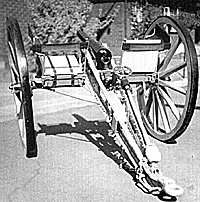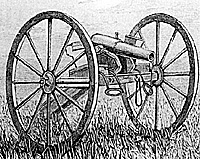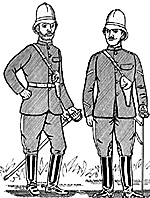 Although the following is mainly intended to describe the uniforms worn by the Royal Artillery in the 1879 Zulu War, an outline is given of the role of the various batteries which were involved. Greater detail - including the names of officers - has not been given, as this can be found in the numerous books which have been written about the war.
Although the following is mainly intended to describe the uniforms worn by the Royal Artillery in the 1879 Zulu War, an outline is given of the role of the various batteries which were involved. Greater detail - including the names of officers - has not been given, as this can be found in the numerous books which have been written about the war.
At right, a 7 pdr RML gun on 'Kaffrarian' carriage, now on display in the SA Museum of Military History.
The Artillery in South Africa at the outset of the Zulu War consisted of N Battery, 5th Brigade, Royal Field Artillery, and 11 Battery, 7th Brigade, Royal Garrison Artillery. The former had taken part in the Cape Frontier ('Kaffir') War the previous year. The first invasion of Zululand, in January 1879, consisted of five seperate columns. One section of 11/7 was assigned to the No. 1 Column (Pearson's) with two 7 pdr rifled muzzle loading (RML) guns and a rocket trough, while the other two sections were attached to No. 4 (Wood's) Column with four 7 pdr RMLs and two rocket troughs. N/5 Battery was assigned to the ill-fated No. 3 (Centre) Column, with six 7 pdr RMLs and two rocket troughs. The subsequent disastrous destruction of part of No. 3 Column by a Zulu force at Isandlwana has been recorded in numerous works; Lieutenant H. T. Curling RA, who survived, left an account of the fate of those members of N/5 who were present at the battle.
![]() Mackinnon and Shadbolt's The South Africa Campaign 1879, published in 1880 (and recently reprinted by Greenhill Books) contains details concerning Major Stuart Smith RA who was killed at Isandlwana.
Mackinnon and Shadbolt's The South Africa Campaign 1879, published in 1880 (and recently reprinted by Greenhill Books) contains details concerning Major Stuart Smith RA who was killed at Isandlwana.
At right, the funeral of the Prince Imperial of France, held at Telezeni camp, 2nd June, 1879. The body is mounted on a 9 pdr gun carriage. (IK)
It is stated that Major Smith 'calmly and intrepidly spiked his gun, and in doing so received his death wound' (there were actually two guns left in the camp). This is quite erroneous as Lt. Curling specifically stated that 'the guns could not be spiked, there was no time to think of anything, and we hoped to save the guns at the last moment'.
In the event, both guns were limbered up, but in the attempt to escape came to grief on the rough ground, one overturning, while the other toppled over a ravine with the horses hanging in the traces. Lieutenant W.F.D. Cochrane of the 32nd Regiment, who also survived, likewise stated that there was no time to spike the guns.
The victorious Zulu army later hauled both guns away. A leading Zulu who after the war was arrested, and who had fought at Isandlwana, said that only one man among them knew anything about loading a cannon, and he tried - but the shot fell only a few yards off. Both guns were later recovered in August 1879 by a mounted patrol, being found in a donga near a Zulu homestead, a few miles from oNdini. The guns were dismounted from their carriages, which were slightly broken and knocked about.
In the homestead one of the rammers was found and a limber box full of shell, and some live rockets. The Zulus had never fired the guns, which were fired by means of a friction tube. This was a hollow copper tube filled with an inflammable composition, and which was inserted into the touch hole of the barrel. Through the top of the tube there was a roughened metal strip with a ring at one end, to which a lanyard was attached. Pulling the lanyard drew the strip across, igniting the composition, and sending a spark down the tube into the barrel, setting off the charge and firing the projectile. The Zulus, not being aware of this method of firing, had screwed percussion nipples into the touch-holes or vents of the guns.
 The 7 pdr found little favour in Zululand being of low velocity and range, which was of little use in the open country. Donald Morris in his The Washing of the Spears mentions that at Isandlwana the guns did little damage against the advancing Zulus, who had noticed the gunners springing back before the lanyards were pulled, and who therefore threw themselves on the ground, so that the shells passed over their heads.
The 7 pdr found little favour in Zululand being of low velocity and range, which was of little use in the open country. Donald Morris in his The Washing of the Spears mentions that at Isandlwana the guns did little damage against the advancing Zulus, who had noticed the gunners springing back before the lanyards were pulled, and who therefore threw themselves on the ground, so that the shells passed over their heads.
The guns were mounted on 'Kaffraria' carriages, which were slightly lighter versions of the 9 pdr gun carriages. N Battery 6 Bde RFA, which came out to Zululand in March 1879, was, however, armed with six proper 9 pdrs. The rockets which were carried by the batteries, one trough per section, proved to be next to useless.
 10/7 Battery RGA, which also formed part of the reinforcements - it came from its station in Mauritius - was the first Gatling gun battery formed in the Army, being organised as such on arrival in Natal. The guns - four in all - were mounted on light field carriages, and drawn by Cape 'tats' (ponies).
10/7 Battery RGA, which also formed part of the reinforcements - it came from its station in Mauritius - was the first Gatling gun battery formed in the Army, being organised as such on arrival in Natal. The guns - four in all - were mounted on light field carriages, and drawn by Cape 'tats' (ponies).
At right, two Gatlings of 10/7 Battery which were present at Ulundi; Major Owen, who commanded them during the battle, stands in front of the gun on the left. Note the open ammunition box, centre. (IK).
In action, the guns were prone to jamming, but this was not due to any fault of the gun, but to the use of the ordinary British rifle cartridge, which was made of thin rolled brass. The Gatling's extractor tended to tear off the base of the cartridge, leaving the brass part stuck in the barrel chamber. Two of these guns were used in the final battle of Ulundi. In August, however, the guns were returned to store, and the Gatling was never again used by the British Army in action.
11/7 Battery took part in the battle of the Nyezane river on the 22nd January, and the section with its two guns formed part of the defences of the mission station at Eshowe, during its siege by the Zulus. The other two sections with No. 4 Column were in action at Khambula on the 29th March.
Among the reinforcements which arrived in March were M, N, and O Batteries, RFA, one section of 8 Bty, 7th Bde, RGA, and, as mentioned above, 10/7 Bty. The 0/6 Bty was employed as an ammunition supply column.
For the second invasion of Zululand the force was formed into three divisions and the batteries were assigned as follows - 1st Division, M/6, 8/7, 11/7 and 0/6. 2nd Division, N/5, N/6, 0/6. Flying Column, 11/7 and 10/7. Two Gatlings of 10/7 were left as part of the garrison of a constructed post called Fort Newdigate in June.
At the battle of Ulundi, which finally defeated the Zulus, the batteries which were present were N/6, with its six 9 pdr guns, 10/7 with two Gatlings, and 11/7 with six 7 pdrs. The action was so short that the overall expenditure of ammunition was small.
 At the end of July 10/7 Bty was selected to form part of the column which, along with another, was formed to search for the fugitive Zulu king, Cetshwayo.
At the end of July 10/7 Bty was selected to form part of the column which, along with another, was formed to search for the fugitive Zulu king, Cetshwayo.
At right, unidentified RA section with two 7 pdr RML guns, photographed late in the war. (SB Bourquin).
Following his capture in August, the battery returned to Durban where all its equipment was returned to store, and at the end of October it returned to Mauritius.
Uniform
The uniform in the Zulu War consisted of the white tropical cork helmet, minus all metal ornaments and stained light brown. It was furnished with a brown leather chin-strap which was attached inside, and was worn either under the chin, or fastened up over the front peak. One photograph shows the officers wearing their undress blue pill box caps with gold lace band and figuring on top.
 The upper garment was a plain dark blue jacket with a flap pocket on the left breast and fastening by five metal buttons in front. It was common to both officers and other ranks, and the former wore no rank distinctions, but NCOs wore their gold (edged scarlet) rank chevrons on both arms, and good conduct badges were worn on the right cuff. THE NCOs and Other Ranks jacket had shoulder straps with the brigade number below a grenade badge, in gold for Sergeants and yellow for ORs, and, apart from one case, Staff Sergeants had narrow shoulder cords.
The upper garment was a plain dark blue jacket with a flap pocket on the left breast and fastening by five metal buttons in front. It was common to both officers and other ranks, and the former wore no rank distinctions, but NCOs wore their gold (edged scarlet) rank chevrons on both arms, and good conduct badges were worn on the right cuff. THE NCOs and Other Ranks jacket had shoulder straps with the brigade number below a grenade badge, in gold for Sergeants and yellow for ORs, and, apart from one case, Staff Sergeants had narrow shoulder cords.
It is difficult to tell if these are gold or blue. Some officers, however, wore the dark blue patrol jacket with black braid and looping across the front, and Austrian knots on the cuffs. Photographs indicate that some Other Ranks and NCOs wore the full dress pattern tunic of dark blue, with scarlet collar edged with yellow or gold braid, and the same for the Austrian knot on the cuffs, scarlet piping all round and on the edge of the shoulder straps, which had the brigade number and grenade badge, all in yellow or gold. The gold embellishments were actually worn by senior NCOs. Nine buttons in front and two at the rear waist with vertical scarlet piping from each to the bottom of the skirt.
Nether wear was dark blue pantaloons, with a wide scarlet stripe, for mounted personnel, with black leather knee boots and spurs. Dismounted men wore dark blue trousers, also with a scarlet stripe, worn with black leather gaiters and ankle boots. Light tan or brown cord breeches or trousers appear to have been worn by some officers and ORs, however, and in one photograph a Staff Sergeant is wearing blue red striped overalls with leather booting reinforcement around the lower part and partly inside the leg. Other garments worn were pullovers and woollen type cap comforters.
Revolvers were issued to mounted men, and all gunners except working numbers carried slung Snider carbines. The revolvers were carried in holsters attached to a narrow strap over the shoulder, all brown leather, although some wore the holster on the waist belt. Officers also carried revolvers in the same manner, and narrow brown leather waist-belts with plain prong buckles. Swords were carried by officers, the scabbard being suspended by brown leather slings to a belt of some form, worn under the jacket, or by slings to the narrow waist belt. Sword hilt knots are only apparent in photographs in one or two cases.
Swords were also carried by mounted personnel among the men, except drivers, and are to be seen suspended by the leather slings to a belt under the jacket. Staff Sergeants also carried swords and revolvers, worn similar to officers. It is possible, however, that although swords are visible in photographs, they were not necessarily worn in action.
Gunners by regulation carried sword bayonets in a frog on a waist belt. This was of buff leather, normally whitened, but stained brown in the Zulu War. The belt for the RGA was adapted in that it had brass dee loops in front for attaching the braces of the 1871 Valise equipment. The belt fastener was a plain brass S hook type. This pattern belt is clearly visible in a photograph from the Royal Collection of Wheeler John Cantwell, N/5 Battery, reproduced in Ian Knight's book, Nothing Remains But To Fight; The Defence of Rorke's Drift. This photograph was taken after the war, when Cantwell was by then a member of 8 Brigade, RGA. It is also interesting to note that he is wearing the newly introduced 1879 Artillery Pattern sword bayonet. RFA dismounted gunners wore the older pattern plain buff belt which had a brass rectangular plate fastener, bearing the crowned garter device with motto and shield of the Royal Arms with rose thistle and shamrock wreath all round, and scroll below inscribed 'UBIQUE'.
In the exiting photographs of groups of artillery in Zululand there appears to be only one instance of the 1878 other ranks undress frock jacket being worn. This was dark blue with a scarlet collar edged yellow around the base and on the shoulder straps, and forming a trefoil design on the cuffs, with a yellow brigade number on the shoulder straps. Sergeants and above had gold edgings instead of yellow, with tracing braid for the Staff. It fastened in front with five buttons with one to each shoulder strap and two on the cuff rear.
There are also one or two instances of a tunic being worn which resembles the full dress one, but is shorter, and more rounded in front at the skirt bottoms, and has a trefoil on the cuffs instead of the Austrian knot, and eight buttons fastening in front, instead on nine. This may be some other type of undress garment. The writer has a photograph of 1880 which shows a group of senior NCOs wearing similar tunics, Staff Sergeants having theirs edged down the front and around the skirts with gold braid.
Sources
The Washing of the Spears, D. Morris (1964)
History of the Royal Artillery, Maj. Gen. Sir J. Headlam (1940)
Royal Artillery Journal Vol. 55 page 23, 1928-29, ibid., Vol. 88, page 43, 1960
The Dress of the Royal Artillery, D. A. Campbell, 1971
The Zulu War; A Pictorial History, M. Barthorp, 1980
Brave Men's Blood, I. Knight, 1990
Military Modelling, page 875, December 1987
Swords of the British Army, B. Robson, 1975.
Back to Colonial Conquest Issue 12 Table of Contents
Back to Colonial Conquest List of Issues
Back to MagWeb Master List of Magazines
© Copyright 1996 by Partizan Press.
This article appears in MagWeb (Magazine Web) on the Internet World Wide Web.
Other military history articles and gaming articles are available at http://www.magweb.com